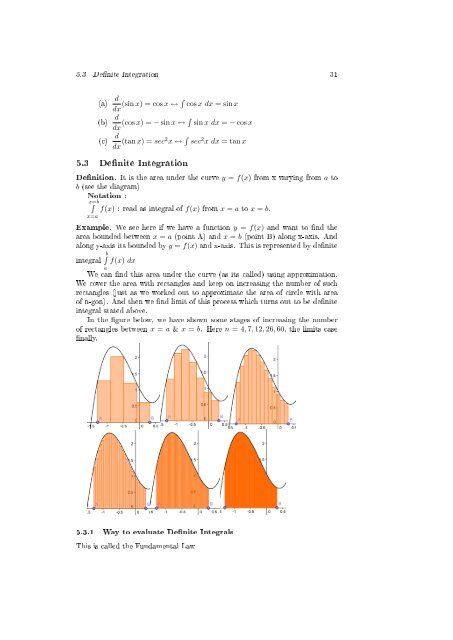Denition approach of learning new topics
You also want an ePaper? Increase the reach of your titles
YUMPU automatically turns print PDFs into web optimized ePapers that Google loves.
5.3 Denite Integration 31<br />
(a)<br />
d<br />
dx (sin x) = cos x ↔ ´ cos x dx = sin x<br />
(b)<br />
d<br />
dx (cos x) = − sin x ↔ ´ sin x dx = − cos x<br />
(c)<br />
d<br />
dx (tan x) = sec2 x ↔ ´ sec 2 x dx = tan x<br />
5.3 Denite Integration<br />
<strong>Denition</strong>. It is the area under the curve y = f(x) from x varying from a to<br />
b (see the diagram)<br />
Notation :<br />
x=b ´<br />
f(x) : read as integral <strong>of</strong> f(x) from x = a to x = b.<br />
x=a<br />
Example. We see here if we have a function y = f(x) and want to nd the<br />
area bounded between x = a (point A) and x = b (point B) along x-axis. And<br />
along y-axis its bounded by y = f(x) and x-axis. This is represented by denite<br />
integral<br />
´b<br />
a<br />
f(x) dx<br />
We can nd this area under the curve (as its called) using approximation.<br />
We cover the area with rectangles and keep on increasing the number <strong>of</strong> such<br />
rectangles (just as we worked out to approximate the area <strong>of</strong> circle with area<br />
<strong>of</strong> n-gon). And then we nd limit <strong>of</strong> this process which turns out to be denite<br />
integral stated above.<br />
In the gure below, we have shown some stages <strong>of</strong> increasing the number<br />
<strong>of</strong> rectangles between x = a & x = b. Here n = 4, 7, 12, 26, 60, the limits case<br />
nally.<br />
5.3.1 Way to evaluate Denite Integrals<br />
This is called the Fundamental Law



